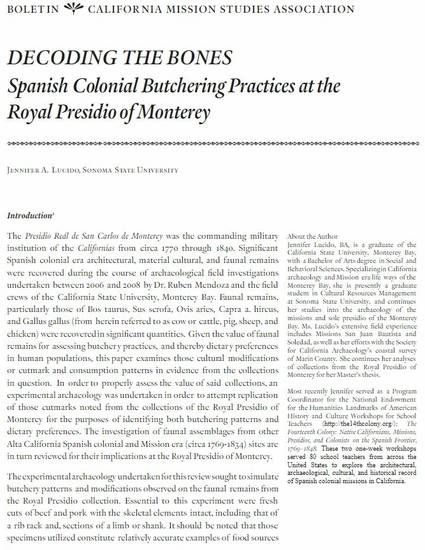
Article
DECODING THE BONES: Spanish Colonial Butchering Practices at the Royal Presidio of Monterey
Boletín
(2013)
Abstract
The Presidio Reál de San Carlos de Monterey was the commanding military institution of the Californias from circa 1770 through 1840. Significant Spanish colonial era architectural, material cultural, and faunal remains were recovered during the course of archaeological field investigations undertaken between 2006 and 2008 by Dr. Ruben Mendoza and the field crews of the California State University, Monterey Bay. Faunal remains, particularly those of Bos taurus, Sus scrofa, Ovis aries, Capra a. hircus, and Gallus gallus (from herein referred to as cow or cattle, pig, sheep, and chicken) were recovered in significant quantities. Given the value of faunal remains for assessing butchery practices, and thereby dietary preferences in human populations, this paper examines those cultural modifications or cutmark and consumption patterns in evidence from the collections in question. In order to properly assess the value of said collections, an experimental archaeology was undertaken in order to attempt replication of those cutmarks noted from the collections of the Royal Presidio of Monterey for the purposes of identifying both butchering patterns and dietary preferences.The investigation of faunal assemblages from other Alta California Spanish colonial and Mission era (circa 1769-1834) sites are in turn reviewed for their implications at the Royal Presidio of Monterey.
The experimental archaeology undertaken for this review sought to simulate butchery patterns and modifications observed on the faunal remains from the Royal Presidio collection. Essential to this experiment were fresh cuts of beef and pork with the skeletal elements intact, including that of a rib rack and, sections of a limb or shank. It should be noted that those specimens utilized constitute relatively accurate examples of food sources for the presidial soldiers and Native Californian laborers at the Presidio of Monterey, as determined from those faunal elements examinedfor this study. John Grafton, who specializes in Spanish colonial ironwork techniques and traditions, recreated Spanish Colonial era metal tools, including knives/cleavers, machetes, saws, axes, and other tools utilized in this study.
Publication Date
2013
Citation Information
Jennifer Lucido. "DECODING THE BONES: Spanish Colonial Butchering Practices at the Royal Presidio of Monterey" Boletín Vol. 29 Iss. 1&2 (2013) Available at: http://works.bepress.com/jennifer-lucido/6/
